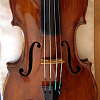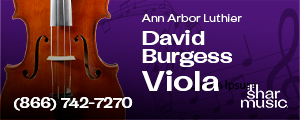V.com weekend vote: Which 'A' do you prefer for Baroque music?
Written by The Weekend Vote
Published: December 12, 2014 at 8:04 PM [UTC]
 How do you like your "A"? Particularly, how do you like your "A" when it comes to Baroque music? Generally, we tune our modern violins to an "A" that is 440 hertz, but the pitch did not used to be so standardized. Those who adhere to "period performances" practices generally tune their violins to a lower pitch that is thought to be more in line with the pitch actually used in the Baroque era: an "A" that is 415 hertz -- much lower. In fact, if you want to just here the pitches, here is a 440 A and here is a 415 A.
How do you like your "A"? Particularly, how do you like your "A" when it comes to Baroque music? Generally, we tune our modern violins to an "A" that is 440 hertz, but the pitch did not used to be so standardized. Those who adhere to "period performances" practices generally tune their violins to a lower pitch that is thought to be more in line with the pitch actually used in the Baroque era: an "A" that is 415 hertz -- much lower. In fact, if you want to just here the pitches, here is a 440 A and here is a 415 A.More interesting to me, though, is how different these tuning systems sound, when one plays Baroque music. I've put together two examples of the same piece, one played in a standard "modern" way, using A=440, and another played in the "period performance" way, using A=415. Which do you like better? Please participate in the vote, and then share your comments and thoughts about tuning.
Our two examples are the first movement from the Bach Double (Concerto in D minor for Two Violins and Orchestra)
A=440 (modern): Itzhak Perlman and Isaac Stern play the Bach Double, I
A=415 (period performance) Rachel Podger and Bojan Cicic play the Bach Double, I
Tweet
Posted on December 12, 2014 at 8:31 PM
I would love to play at A415, but the practicalities of playing in modern orchestras unfortunately forbid it, even though I habitually use 3 gut + steel E on both my instruments.
It's probably not a good idea to be re-tuning a violin up and down between A415 and A440, so the only way I'm going to play Baroque in-the-style-of is to get a Baroque violin, but that's going to depend on advice from my in-house "Financial Advisor" ;)
Posted on December 12, 2014 at 8:39 PM
Posted on December 12, 2014 at 8:58 PM
Posted on December 12, 2014 at 10:18 PM
Posted on December 12, 2014 at 10:23 PM
Having flutes I must play at their pitch.
One of my favorites for early French and even up to some J.S. Bach is at A=392. I also have 1-keys at 415 and 440.
There is a early flute player in town who I talked with two decades ago. He had a Folkers & Powell Palanca copy with corps de rechange for A=440, 430 and 415. Each setup had a different sound. BTW A=430 is used for Gallant and Early Classical music.
I also have several recordings of flute music where A=400.
Sometimes it is better to change the A than to redesign the instrument.
Posted on December 12, 2014 at 11:20 PM
For listening, I can adapt to 415 or 440 tuning easily. 415 is about 1/2-step below 440; so if the piece is in the key of A, I just think of it as transposed down 1/2 to A-flat. As a listener, I can live with that. I'm less comfortable hearing a tuning somewhere in between these two numbers. My perfect pitch isn't so absolute that I can't tolerate 1-2 vibrations of difference +/-; but beyond that, I can always tell when the players aren't tuned to the A-440 I've geared myself to from childhood.
For playing, though, I definitely have settled on 440. And my modern instruments have a sheen at this tuning that unfortunately starts to fade with lower tuning. I get myself mentally, physically, and emotionally pumped up before practice, especially the evening session, by taking a walk while listening to music in keys favorable to violin and guitar -- A, D, G. This helps make the key pitches ring more vibrantly in my mind's ear before I even start tuning.
FWIW, the tone at the top of the hour on some radio networks is A-440.
Posted on December 13, 2014 at 12:32 AM
Posted on December 13, 2014 at 12:38 AM
I can't possibly be the only person to have heard it. I'm happy to share these recordings and more, if you'd like. Question: why does no one talk about how high A's are these days? Personally, I'm fine with it. I think it's soinds better. Apparently, many major modern recording artists do, too.
Posted on December 13, 2014 at 12:51 AM
Trevor -- I'm curious why you say it's probably not a good idea to be re-tuning the violin up and down between A415 and A440. I hope it's not bad for the violin, as I've been doing a lot of it lately...
Posted on December 13, 2014 at 1:38 AM
Posted on December 13, 2014 at 3:46 AM
Posted on December 13, 2014 at 3:58 AM
Posted on December 13, 2014 at 9:04 AM
I my study of music, I have discovered that unlike pop music which are produced for consumers, "classical" music took on a spiritual expression with marketability thrown in as a matter of practicality, and in many case has no commercial contents at all. Vivaldi wrote his music mostly for the girls and women at the orphanage, and Beethoven pretty much wrote what he wanted and publishers would pay for it.
Since classical music has the highest depth in all music, understanding the CONTEXT is important.
So playing Bach with period instruments tuned to lower A was what Bach wrote....
That however did not invalidate his music played on modern instruments at 440 as Bach's music certainly has far greater potential than just using period instruments at A415, it even works with cross over and pop! :-) That however does not make his compositions greater, just different, which again his music had the potential for them.
I hope other readers may be able to share my feeling is that in the boroque version, I hear more Bach and his music, and the musicians were invisible, serving the music, whereas in the modern version, by Stern and Zukerman no less!!!!, the virtuosity and the beautiful playing of the soloists cuts through.
In the days of Bach and Beethoven, Concerto or Konzart in Bach and Beethoven's native language meant together, meaning that the orchestra and soloists perform together to form a greater instrument, and even though the soloist had his/her opportunity to show off, it was meant to be showing off as an integral part of the orchestra, much like a note standing out on a piano, but as time evolved, soloists often feel the concertos were written for them and the orchestra is simply the accompaniment. (That was not the case until Paganini came along! )
So one is the original, the other is the evolution.
To me ultimately, it's the musicians serving the music, and Konzert means in concert means together.
also the A415 changes not just the pitch, it changes the instruments and the playing!
So I vote for the A415 with period instruments.
Posted on December 13, 2014 at 10:04 AM
That being said, I would enjoy a 415 or something like that (who sure we are it was always THAT standarized at those times? :) ) with instruments that can handle it. I tried this on my backup instrument, and it sounded a little wolfy.
The core of the music would be the same. There would be millions of ways to perform it, with every equipment combination, and every tuning.
P.S. I still insist on 440 Hz, if I am the one to play Bach. Some pianos in my conservatory are a little higher or lower than 440 (not that far as 415) and it drives me insane.
Have a nice day everybody!
Posted on December 13, 2014 at 11:45 AM
On the other hand, some thirty or so years ago I talked to the violinist granddaughter of a well-known British composer about baroque pitch (I don't think she accesses this site - She certainly hasn't posted) and she said, "For the first month playing baroque, it was absolute torture. After then, though, I found I had two absolute pitches". So people with absolute pitch CAN cope eventually.
Posted on December 13, 2014 at 3:47 PM
What a Curse! Thank god I don't have perfect pitch. What a pity that would be. I wonder if there is a way to do ear training to get rid of it? You often see quacks purporting to be able to train perfect pitch (why the hell would you want it?!) but not the other way. Business opportunity there.
Posted on December 13, 2014 at 3:53 PM
Posted on December 13, 2014 at 7:17 PM
I have absolute pitch and find it very difficult to play on a violin tuned to 415. I have a violin with a semi-baroque setup - pure gut strings, baroque tail piece, bridge and bow (but otherwise a modern instrument). Initially I tuned it to 415, but it was a pain to play it. I basically had to transpose in my head while letting the fingers play non-transposed. So now I tune that violin to 440 instead. It changes the sound somewhat, but I think it could be partly "fixed" with lower tension strings.
When playing Mahler 4 recently I was given the opportunity to play the scordatura solo. A bit off topic here, but it presented the same problem with having absolute pitch. I had to think A while letting the fingers play G. If I just tried to "play without thinking" I couldn't play in tune.
Posted on December 14, 2014 at 6:07 AM
1) Pitch level is a separate issue from "tuning systems".
2) As Raphael pointed out - thank you! - different cities's As varied widely, from A=392 in Versaille court to A=466 in Venice, and even within a region there were often different As for court, opera, and church.
3) A=415 is a modern compromise for the modern harpsichord so they can conveniently shift the whole keyboard down a half step from modern A=440, and voila, you have a "baroque" pitch level.
This poll's question is basically flawed because it's suggesting you either tune to the modern A or the "baroque" A, which I hope everyone will now understand wasn't used by everyone in Europe and certainly wasn't decided for it historical authenticity. If you really want to be historical about it, how about having the third option of tuning to the A that the composer worked with, which is what a lot of recordings do if they are just devoted to one composer or region.
Also comparing those recordings aren't fair, because what's more striking is the performance style of the players, as it's been mentioned. It'll be more interesting if you compared two clips of the same recording at different pitches and see if people preferred one or the other.
Posted on December 14, 2014 at 2:44 PM
....HiDe
Posted on December 14, 2014 at 4:16 PM
As to perfect pitch, I, too, was born with it and have found it to be basically unhelpful. In my twenties, I was a freelance professional singer in Manhattan. In acapella groups, where, over time, the pitch tends to sag a bit, the perfect pitch was a nuisance.
However, as I have aged, I find that my "perfect pitch" has sagged along with other parts of my body. I think that this is not unusual. Therefore I can easily adjust to hearing 415.
The quality of the performance, rather than the pitch is what I look for. Also, the major difference to me is the different sound that the gut strings make. This is more noticeable to me than the pitch. I like the more"human" and natural gut sound.
Posted on December 14, 2014 at 10:53 PM
Does anyone know how the frequency was measured in 1750?
Re: Gut.
Yes, plain uncovered gut e and a have a beautiful sound that is simply incomparable. Not that it is superior to steel e but when played well, it is absolutely gorgeous and once you know it, you instantly recognize it. The should makes me feel warm in my chest -- can't really explain it any other way.
Posted on December 15, 2014 at 12:13 PM
Posted on December 19, 2014 at 4:58 PM
1. Echoing what some previous posters have said: I've read for some time now that the A pitch was quite variable from one place or one ensemble to another during the Baroque period. I personally don't like the idea of tuning my instruments down and up. As indicated before, I'm a 440 adherent. One reason, I'm sure, that tuning isn't a big deal with me is that I'm very strict about tuning consistently and checking myself against the A-440 tuner or tuning fork several times throughout the session -- just to be sure. I seldom have to re-tune.
2. I thank singers -- notably the late Renata Tebaldi -- for putting their collective foot down on this issue and holding the line on pitch inflation. I've previously cited Tebaldi's interview some years back with Lanfranco Rasponi. See:
http://www.renata-tebaldi.com/rasponi.htm
Just search on the page for 440 to read what the lady has to say on the matter. If you have time, the whole article is interesting, too.
This entry has been archived and is no longer accepting comments.
Violinist.com is made possible by...
Violinist.com Holiday Gift Guide
Dimitri Musafia, Master Maker of Violin and Viola Cases
International Violin Competition of Indianapolis
Johnson String Instrument/Carriage House Violins
Subscribe
Laurie's Books
Discover the best of Violinist.com in these collections of editor Laurie Niles' exclusive interviews.

Violinist.com Interviews Volume 1, with introduction by Hilary Hahn

Violinist.com Interviews Volume 2, with introduction by Rachel Barton Pine







